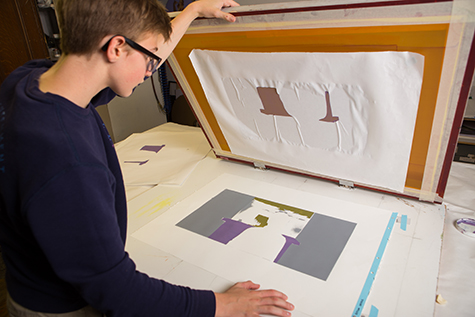ChatGPT said: What customers are saying in 10:9 Design reviews: insights
Wiki Article
The Essential Overview to Comprehending Screen Printing and Its Versatile Makes use of
Screen printing has a rich background that goes back to ancient times, developing right into an advanced technique utilized across different industries today. This overview checks out the intricacies of the screen printing procedure, outlining its applications in home, advertising and marketing, and style style - 10:9 Design Screen Printing. Understanding these basics can open up creative capacity for both imaginative and commercial jobs. The complying with areas will expose crucial tips and methods to boost one's screen printing undertakingsThe History of Screen Printing
Although screen printing has origins that trace back centuries, its development shows the technological and creative developments of various cultures. Stemming in old China, the technique was originally used for embellishing textiles and later spread to Japan, where it ended up being indispensable to Ukiyo-e woodblock printing. The approach shifted to Europe in the 18th century, where it got appeal among craftsmens and industrial printers. The invention of photo solution in the 20th century transformed screen printing, enabling even more complex styles and greater efficiency. Musicians like Andy Warhol additionally propelled its appeal, making use of the tool to develop iconic jobs that mixed commercialism and art. By the late 20th century, screen printing had established itself as a functional technique, employed in fashion, advertising, and art. Today, it remains to evolve, integrating digital modern technology and expanding its applications throughout various markets.The Screen Printing Process Explained
Screen printing changes imaginative visions into concrete layouts with a collection of accurate actions. A photo is developed and after that transferred onto a screen, generally made of fine mesh textile extended over a structure. A light-sensitive emulsion is put on the screen, which is revealed to light, setting in locations not covered by the photo. After washing out the unhardened solution, a stencil is created.Next off, the screen is positioned over the substrate, whether it be fabric, paper, or one more product. Ink is after that pushed with the open areas of the pattern using a squeegee, depositing the design onto the substrate below. This process can be repeated for multiple colors, needing different displays for each and every hue. Lastly, the printed product is cured using heat to guarantee the ink adheres properly, resulting in a long lasting, vivid layout on-line.
Sorts Of Screen Printing Techniques
.png)
Additionally, specialized strategies, such as discharge screen printing, remove color from the material to produce softer prints, while foil screen printing applies metallic aluminum foil to accomplish a shiny finish (10:9 Design Screen Printing). Each method provides distinct characteristics, accommodating different innovative needs and manufacturing scales, inevitably broadening the possibilities within the screen printing domain name
Applications of Screen Printing in Various Industries

Furthermore, the signage and advertising and marketing industries utilize screen printing for producing appealing display screens and banners. This method permits bold shades and intricate styles that capture interest. In electronic devices, screen printing is utilized for using conductive inks to circuit boards, necessary for part connections. The home design sector embraces screen printing to create unique layouts on textiles and wall surface art. On the whole, screen printing offers as an essential tool across varied areas, improving products with customized and visually attractive graphics.
Tips for Successful Screen Printing Projects
While embarking on a screen printing job, careful interest to detail can significantly enhance the final end result. First, picking top notch materials is essential; this includes the screen, inks, and substratums. Making use of proper mesh matters can affect ink deposition and information resolution. Prep work is similarly essential; extensive cleaning of displays and proper direct exposure times ensure crisp prints.Next, exact registration is crucial for multi-color prints. Utilizing placement devices can help attain accurate layering. Additionally, screening prints on scrap materials prior to manufacturing helps recognize prospective issues without wasting sources.

Often Asked Concerns
What Materials Are Ideal for Screen Printing on Material?
Cotton and polyester blends are suitable for screen printing on material because of their sturdiness and ink absorption. Furthermore, specialty textiles like silk or canvas can create distinct textures and surfaces, improving the total style quality.Just how Do I Tidy and Maintain Screen Printing Devices?
To maintain and cleanse screen printing devices, one should frequently wash displays with appropriate solvents, inspect mops for wear, lubricate relocating parts, and shop all things in a dry, dust-free setting to prolong their life expectancy.What Are the Environmental Influences of Screen Printing?
Screen printing can have considerable ecological influences, consisting of chemical waste from inks and solvents, water usage throughout cleansing procedures, and energy usage. Green products and lasting techniques are vital for decreasing these negative effects.Can Screen Printing Be Done at Home Efficiently?
Screen printing can be successfully done at home with the appropriate products and strategies. Enthusiasts can develop top quality prints, though success relies on their ability degree, tools, and understanding of the procedure included.
What Are the Costs Related To Starting a Display Printing Business?

Starting a screen printing company involves prices for devices, materials, and work space. Preliminary expenses typically vary from a few hundred to numerous thousand dollars, depending on the range, high quality of equipment, and get more info preferred production capacity.
Screen printing has an abundant history that dates back to old times, advancing into a sophisticated strategy made use of throughout various industries today. An additional method, rotary screen printing, uses round screens, helping with continuous printing on material rolls, thus improving performance for massive manufacturings. Furthermore, specialized techniques, such as discharge screen printing, remove color from the fabric to develop softer prints, while foil screen printing applies metal foil to accomplish a shiny coating. In the fashion sector, screen printing is extensively utilized to produce lively styles on garments, allowing brands to display their unique designs. Cotton and polyester blends are excellent for screen printing on material due to their durability and ink absorption.
Report this wiki page